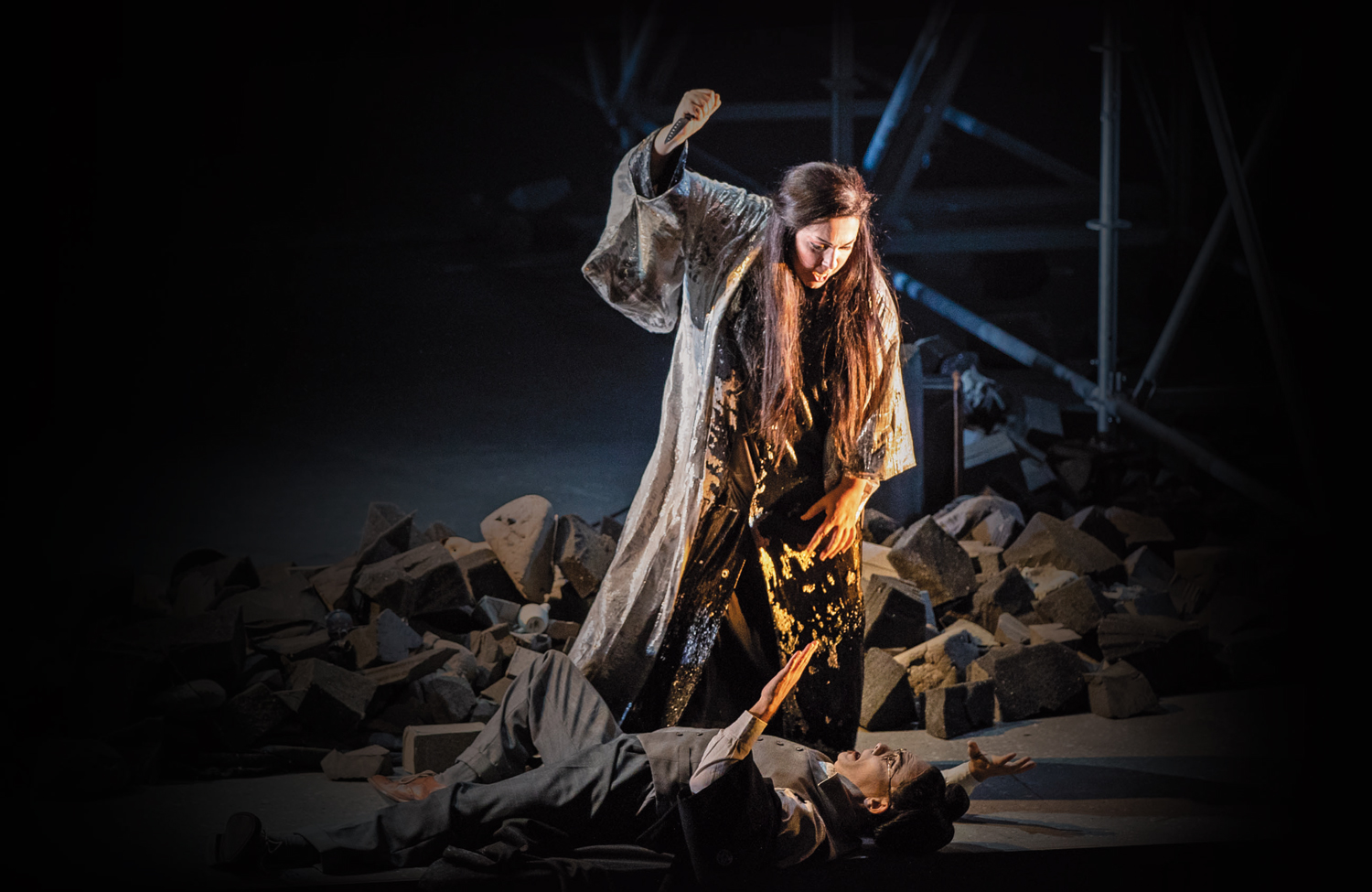

The eagerly-awaited presentation of Giacomo Puccini’s “Madama Butterfly” at the Royal Opera House Muscat was given two spectacular performances last weekend and exceeded all expectations.
This innovative 2017 production by the Festival Castell Peralada in co-production with Deutsche Oper am Rhein was created by the Andorran Director, Joan Antón Rechi. It was given a fresh verismo interpretation reflecting contemporary insight into this most popular of operas. Before curtain up there was an opportunity for ticket-holders to attend a talk with the Director from the private, family-owned Opera Festival set in the Catalan Pyrenees.
Rechi explained that “Madama Butterfly” is more Greek Tragedy than romantic melodrama; more Italian Opera than Japanese, dripping with Italian passion and sensibility. Thus he set most of the drama in the Westernised bureaucratic US Consulate in 1940s Nagasaki rather than the traditionally colloquial Japanese house. At the end of Act One, an atomic bomb falls and destroys the city leaving Butterfly vulnerable and destitute, abandoned by her community and out of her cultural context in a hostile environment. She is no longer just a naive geisha, a victim of individual destiny; she represents part of the collective emotional memory on an apocalyptic scale.

Set designer Alfons Flores incorporated rotating ‘doughnut’ scenery, opening with a wedding in the Consulate in Art Deco style complete with Chesterfields and classical monumental pillars. It was a stroke of genius, giving the narrative a sense of constant movement and progression. Act One exuded lightness of mood and joyfulness. The Italian Roberto Aronica played a robust, confident Pinkerton as the unfaithful lieutenant, but his beautiful, warm tenor voice was immediately beguiling as seducer and lover in his first lengthy aria, ‘Dovunque al Mondo’ (Throughout the world).
The Roman mezzo-soprano Veronika Simeoni was perfect as the loyal companion Suzuki throughout the whole opera, here in excited, animated tones full of anticipation for her friend. Later she reached depths of emotion in the sublime duet with Cio-Cio-San in Act Two. The conniving property agent and matchmaker, Goro, was played energetically with characterised whitened face by the brilliant Barcelona-born tenor, Vicenç Esteve, sung with lively, witty ease, in keeping with his devious role.
The highly acclaimed Catalan Costume Designer, Mercè Paloma, explored the 1940s theme with stylised flair. As the Ladies’ Chorus made their breath-taking entrance on the revolving stage concealed under parasols it was only Cio-Cio-San herself, in a concession to Japanese decoration, who wore kimonos.
Uruguayan soprano, Maria José Siri, as the innocent fifteen-year-old Geisha was simply superb. The role is hugely demanding with much of it in a sustained high tessitura. Siri pouted and mimicked the gesture of a nubile teenager with convincing acting ability. Her glistening crystal high register in Act One led to moving lyricism and pathos in the second acts of the tragedy. It was a performance of epic stamina and development as she aged more than the three-year time-span of the three-hour performance.
The Madrid-based ‘Intermezzo Coros a la Carta’ under its esteemed Choirmaster, Ricardo Estrada, was exceptional, portraying family, community and commentator on the action, especially in the stunningly evocative ‘Humming Chorus’ Entr’acte. Established a hundred years ago, the Bilbao Orkestra Sinfonikoa provided a flawless interpretation of Puccini’s lyrical 1904 score under the charismatic Italian opera-conductor, Marco Armiliato. The music is poetically descriptive, infused with genuine Japanese melodies, leitmotivs, snatches of the American National Anthem and pentatonic passages in a harmonic language sometimes ahead of its time. The large orchestra brought out the pathos of the lush, romantic 20th-century score with splendid articulation and control. In contrast, Puccini’s lavish use of whole-tone melodies evoked the decadence of Western values in general, and malevolent actions in particular. Led by her furious Uncle Bonze, Butterfly’s family eject her from society. Roberto Aronica as Pinkerton showed his compassionate side in comforting words, reflecting a real love – even if short-lived – in the beautiful Love Duet, ‘Vogliatemi bene’.
The devastation of the Consulate in Nagasaki in Act Two provided a metaphor of Butterfly’s life, while Suzuki’s Japanese prayer reflected the conflict between cultures. There was no pause between Acts Two and Three and that helped maintain the momentum and build-up of tension as the women waited endlessly for Pinkerton’s return. Siri infused so much poignancy into, ‘In Bel dì Vedremo’ (One Beautiful Day), always believing he would return and rescue her and their son one day, as she kept her constant watch on the horizon. The child-role of Dolore, Cio-Cio-San’s child was one of the longest seen at ROHM and was endearingly played by six-year-old Taimur alBusaidi.

Butterfly’s naive trust was palpable as the US Consul, Sharpless, played by the Georgian baritone George Gagnidze, read Pinkerton’s letter to her, omitting that he was returning with his new American wife. In Pinkerton’s final aria, ‘Addio fiorito asil’ one finally perceived a glimpse of guilt and remorse from the naval officer as he declared that he will always be tormented for his betrayal and never find peace. The ritual suicide of Cio-Cio-San, on the other hand, became a collective cathartic experience of sacrificial proportions for the audience. Tissues in hand, they left the auditorium aware of a more powerful meaning from this successful reinterpretation of a very real tragedy.
STORY BY GEORGINA BENISON
PHOTOS BY KHALID AL BUSAIDI
Oman Observer is now on the WhatsApp channel. Click here



